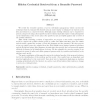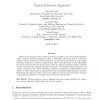77 search results - page 9 / 16 » Security of Blind Signatures Revisited |
PPDP
2005
Springer
2005
Springer
A resolution strategy for verifying cryptographic protocols with CBC encryption and blind signatures
14 years 3 months ago
Formal methods have proved to be very useful for analyzing cryptographic protocols. However, most existing techniques apply to the case of abstract encryption schemes and pairing....
CCS
2009
ACM
14 years 10 months ago
2009
ACM
We revisit the venerable question of access credentials management, which concerns the techniques that we, humans with limited memory, must employ to safeguard our various access ...
PKC
2010
Springer
13 years 11 months ago
2010
Springer
Encrypt-and-sign, where one encrypts and signs a message in parallel, is usually not recommended for confidential message transmission. The reason is that the signature typically l...
IEEEARES
2007
IEEE
14 years 4 months ago
2007
IEEE
Voter anonymity, also known as unlinkability, is the primary requirement to satisfy privacy in e-voting protocols. Up until now, e-voting protocols have tried to make communicatio...
ICISC
2001
13 years 11 months ago
2001
Motivated by emerging needs in online interactions, we define a new type of digital signature called a `Content Extraction Signature' (CES). A CES allows the owner, Bob, of a...


